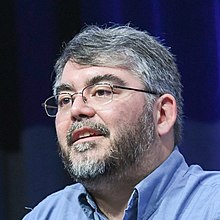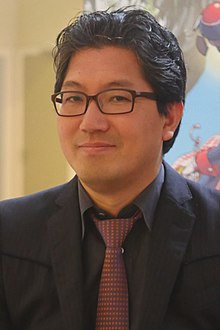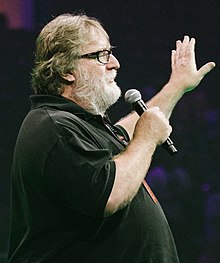Portal:Video games
The Video Games Portal

A video game, also known as a computer game or just a game, is an electronic game that involves interaction with a user interface or input device (such as a joystick, controller, keyboard, or motion sensing device) to generate visual feedback from a display device, most commonly shown in a video format on a television set, computer monitor, flat-panel display or touchscreen on handheld devices, or a virtual reality headset. Most modern video games are audiovisual, with audio complement delivered through speakers or headphones, and sometimes also with other types of sensory feedback (e.g., haptic technology that provides tactile sensations). Some video games also allow microphone and webcam inputs for in-game chatting and livestreaming.
Video games are typically categorized according to their hardware platform, which traditionally includes arcade video games, console games, and computer (PC) games; the latter also encompasses LAN games, online games, and browser games. More recently, the video game industry has expanded onto mobile gaming through mobile devices (such as smartphones and tablet computers), virtual and augmented reality systems, and remote cloud gaming. Video games are also classified into a wide range of genres based on their style of gameplay and target audience. (Full article...)
Featured articles –
System Shock's 3D engine, physics simulation and complex gameplay have been cited as both innovative and influential. The developers sought to build on the emergent gameplay and immersive environments of their previous games, Ultima Underworld: The Stygian Abyss and Ultima Underworld II: Labyrinth of Worlds, by streamlining their mechanics into a more "integrated whole"; it is considered one of the defining examples of an immersive sim.
Critics praised System Shock and hailed it as a major breakthrough in its genre. It was later placed on multiple hall of fame lists. The game was a moderate commercial success, with sales exceeding 170,000 copies, but Looking Glass ultimately lost money on the project. A sequel, System Shock 2, was released by Looking Glass Studios and offshoot developer Irrational Games in 1999. The 2000 game Deus Ex (produced and directed by Spector), the 2007 game BioShock, and the 2017 game Prey are spiritual successors to the two games. A remake by Nightdive Studios was released on 30 May 2023. (Full article...)
Director Shigeru Miyamoto conceived a 3D Super Mario game during the production of Star Fox (1993). Development lasted nearly three years: about one year on design and twenty months on production, starting with designing the virtual camera system. The team continued with illustrating the 3D character models—at the time a relatively unattempted task—and refining sprite movements. The sound effects were recorded by Yoji Inagaki and the score was composed by Koji Kondo.
Super Mario 64 was highly anticipated by video game journalists and audiences, boosted by advertising campaigns and showings at the 1996 E3 trade show. It received critical acclaim, with reviewers praising its ambition, visuals, level design, and gameplay, though some criticized its virtual camera system. It is the best-selling Nintendo 64 game, with nearly twelve million copies sold by 2015. (Full article...)
Kingdom Hearts II is the third game in the Kingdom Hearts series, and takes place one year after the events of Kingdom Hearts: Chain of Memories. Sora, the protagonist of the first two games, returns to search for his lost friends while battling the sinister Organization XIII, a group of antagonists previously introduced in Chain of Memories. Like previous games, Kingdom Hearts II features a large cast of characters from Disney and Square Enix properties.
Concepts for Kingdom Hearts II began during the end of development of Kingdom Hearts Final Mix, with the game entering full development in 2003 and being announced at Tokyo Game Show 2003. Most of the first game's development team returned, including director Tetsuya Nomura, with the game being developed concurrently with Chain of Memories. In developing Kingdom Hearts II, the development team sought to address user feedback from the first game, give the player more freedom and options in combat and present a deeper and more mature plot. (Full article...)
Lightning was created by Motomu Toriyama, the director and scenario writer of XIII, and designed by regular Final Fantasy artist Tetsuya Nomura. The design goal was a character who was less feminine than previous Final Fantasy heroines in both appearance and personality. Aspects of her early design and personality were later altered, or transferred to other characters. After XIII, Lightning's design was revised several times to reflect her role and development in each game, particularly in Lightning Returns. Her real name in Japanese, Éclair Farron, was originally a placeholder. Because of her first name's association with a type of pastry, it was changed to "Claire" in other countries.
Lightning has received mixed commentary from critics—much of it relating to her cold personality, which was compared to that of Final Fantasy VIIs protagonist Cloud Strife. She was criticized for her relative absence in XIII-2. Her role in Lightning Returns met with mixed reception: some critics saw her as underdeveloped and unlikable, while others found her better developed and more human than in previous games. Lightning later appeared on lists, compiled by video game publications, of the best characters in the Final Fantasy series and in video games as a whole. She has been received favorably in polls of public opinion by Famitsu, Square Enix, and other organizations. ('Full article...)
In a departure from previous titles in the Myst series, End of Ages replaces pre-rendered environments with worlds rendered in real-time 3D graphics, allowing players to freely navigate the Ages. The faces of actors were digitally mapped onto three-dimensional character models to preserve realism. The game also includes multiple methods of navigation and an in-game camera.
End of Ages was positively received, despite complaints such as lessened interactivity compared to previous games and poorer graphics. After End of Ages's release, Cyan abruptly announced the end of software development and the layoff of most of its staff, but was able to rehire much of the development team a few weeks later. (Full article...)
In the story, protagonist Neku Sakuraba and his allies are forced to participate in a game that will determine their fate. The battle system uses many of the unique features of the Nintendo DS, including combat that takes place on both screens, and attacks performed by certain motions on the touchscreen or by shouting into the microphone. Elements of Japanese youth culture, such as fashion, food, and cell phones, are key aspects of the missions and character progression.
The World Ends with You received critical acclaim upon release, with critics praising the graphics, soundtrack, and integration of gameplay into the Shibuya setting. The few common complaints were related to the steep learning curve of the battle system as well as the sometimes imprecise touch-screen controls. In the first week of its release, the game was the second best-selling DS title in Japan, and the top-selling DS title in North America. Shiro Amano, writer and artist of the Kingdom Hearts manga, later created a manga based on the video game. An anime adaptation by Square Enix, DOMERICA, and Shin-Ei Animation aired from April 10 to June 26, 2021. (Full article...)
Born in Sapporo, Iwata expressed interest in video games from an early age and created his first simple game while in high school. He majored in computer science at the Tokyo Institute of Technology. In 1980, he joined the game developer HAL Laboratory while attending the university. At HAL, he worked as a programmer and closely collaborated with Nintendo, producing his first commercial game in 1983. Games to which he contributed include EarthBound and many games in the Kirby series. Following a downturn and near-bankruptcy, Iwata became the president of HAL in 1993 at the insistence of Nintendo president Hiroshi Yamauchi and brought financial stability. In the following years, he worked in the development of the Pokémon and Super Smash Bros. series. Iwata joined Nintendo as the head of its corporate planning division in 2000.
Nintendo saw growth under Iwata and, when Yamauchi retired, he became the company's president in May 2002. Under Iwata's direction, Nintendo developed the Nintendo DS and Wii game consoles, helping the company achieve financial success. As a self-declared gamer, he focused on expanding the appeal of video games across demographics through a "blue ocean" business strategy. Nintendo attained record profits by 2009, and Barron's placed Iwata among the top 30 CEOs worldwide. Iwata expanded his strategy by defining a quality-of-life product line for the Wii that evolved into a ten-year strategy to create standalone products. Later hardware such as the Nintendo 3DS and Wii U proved far less profitable than the Wii, and Nintendo's net sales fell by two thirds from 2009 to 2012; the company saw its first operating losses in 30 years during this time. Iwata voluntarily halved his salary in 2011 and again in 2014. In 2015, after several years of refusal, Iwata put a portion of Nintendo's focus into the rapidly growing mobile game market; a landmark partnership with mobile provider DeNA was established that March. Throughout his career, Iwata built a relationship with Nintendo fans through social media and his regular appearances in Iwata Asks and Nintendo Direct, becoming the public face of the company. (Full article...)
Did you know... -
- ... that Rawson Stovall became the first nationally syndicated video game journalist in the United States when he was only eleven years old?
- ... that Paul Dini was a writer for both the animated television series Batman: The Animated Series and the video game series Batman: Arkham?
- ... that the web-based video game Moderator Mayhem was based on a card game meant to demonstrate the difficulties of content moderation?
- ... that Justin Yu, the current Classic Tetris World Champion, is also a cellist in MIT's video game orchestra?
- ... that Through the Darkest of Times was the first video game published in Germany to use swastikas?
- ... that the video game Serious Sam: Tormental was originally inspired by Geometry Wars?
- ... that for at least 90 minutes, Mori Calliope livestreamed herself begging video game developer Atlus to allow her to stream their game Persona 3?
- ... that the game designer of the video game Hades said that the characters were attractive "because Jen Zee"?
- ... that the video game Manor Lords was wishlisted more than three million times on Steam after its developer had estimated it would receive around 14,000?
- ... that the team developing the action video game Knights Contract researched European folklore on witches and witch hunts?
- ... that the 1987 video game Oriental Hero was panned as "so incredibly bad it's almost worth a look"?
- ... that Rockstar Vienna was the largest video game developer in Austria when it closed in 2006?
Selected biography –
Selected image -
Recent video game-related events
- May 24, 2024 – Uvalde school shooting
- Families in Uvalde, Texas, U.S., file a lawsuit against Daniel Defense and Activision Blizzard for creating the DDM4 V7 gun and promoting the weapon through the game Call of Duty, respectively. They also sue Meta Platforms for owning Instagram, which was used by the gunman. (AP)
- April 16, 2024 – 2023–2024 video game industry layoffs
- American video game company Take-Two Interactive lays off 5% of its workforce. (Reuters)
- April 10, 2024 – 2023–2024 video game industry layoffs
- American video game company Epic Games announces that it will lay-off around 870 employees, roughly one-sixth of its workforce, due to slower growth than expected. (CBC via Yahoo! News)
Topics
Categories
Things you can do
In other Wikimedia projects
The following Wikimedia Foundation sister projects provide more on this subject:
-
Commons
Free media repository -
Wikibooks
Free textbooks and manuals -
Wikidata
Free knowledge base -
Wikinews
Free-content news -
Wikiquote
Collection of quotations -
Wikisource
Free-content library -
Wikiversity
Free learning tools -
Wiktionary
Dictionary and thesaurus















































